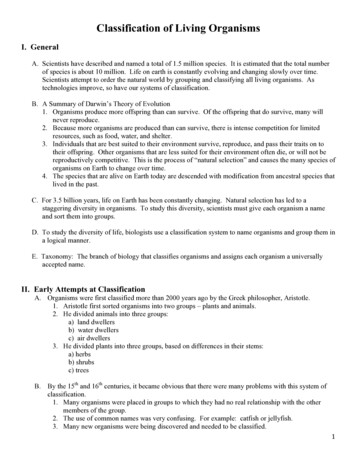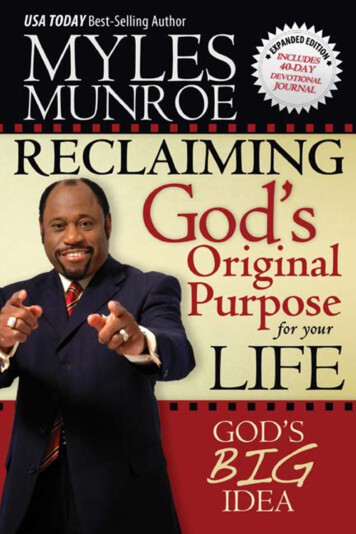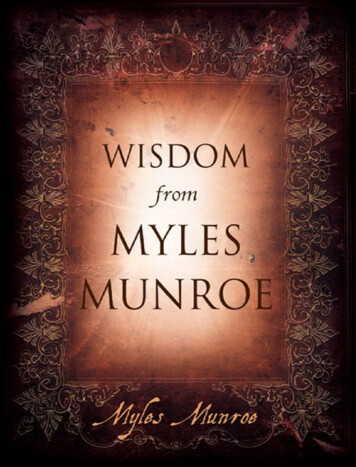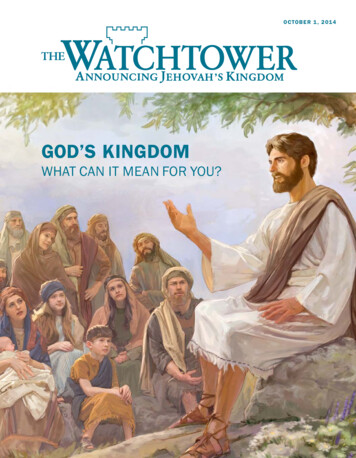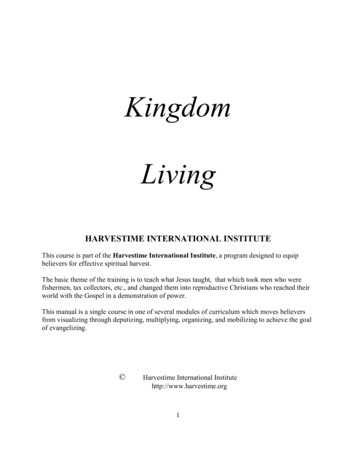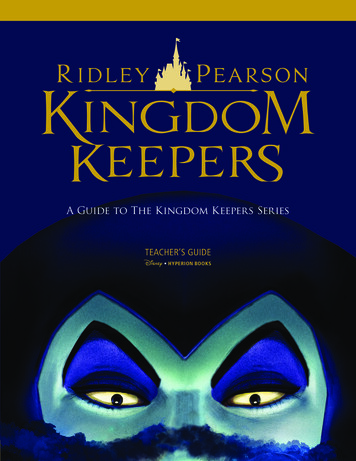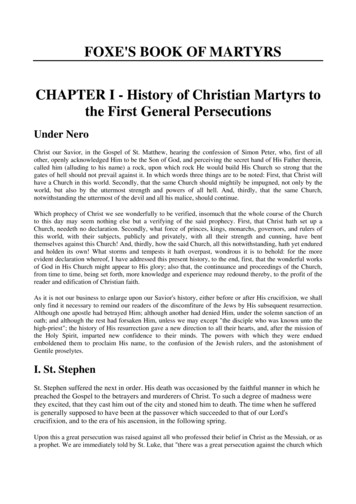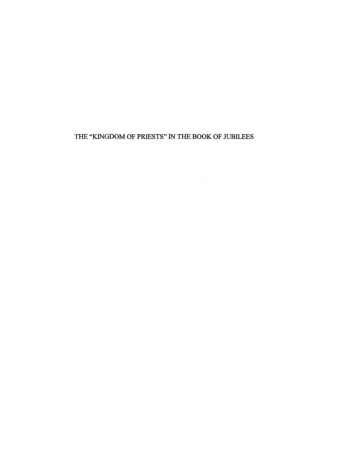
Transcription
THE "KINGDOM OF PRIESTS" IN THE BOOK OF JUBILEES
THE "KINGDOM OF PRIESTS"INTHE BOOK OF JUBILEESByCHRISTINE BOLTON, B.A.A ThesisSubmitted to the School of Graduate Studiesin Partial Fulfilment of the Requirementsfor the DegreeMaster of ArtsMcMaster University Copyright by Christine Bolton, September 2004
MASTER OF ARTS (2004)(Religious Studies)McMaster UniversityHamilton, OntarioTITLE:The "Kingdom of Priests" in the Book of JubileesAUTHOR:Christine Bolton, B.A. (University of British Columbia)SUPERVISOR:Professor E. SchullerNUMBER OF PAGES: v, 97ii
AbstractThis thesis explores the concept of the "kingdom of priests," as presented by theSecond Century BCE text, The Book ofJubilees. It is argued that this phrase, drawn fromExod 19, has been interpreted by the author of Jubilees to mean that any male member ofIsrael may potentially serve as a priest. This priestly role, however, cannot be actualizeddue to the sinfulness of Israel, particularly in its association with and acceptance of gentilesand gentile practices. The model of a priestly Israel is presented in Jubilees through itsportrayals of the major figures of biblical history as priests. This thesis will explore thesepriestly portrayals, with special attention given to Adam, in order to demonstrate thatJubilees believed all of Israel to have priestly potential.iii
AcknowledgementsI owe a great deal of gratitude, first and foremost, to my supervisor, Dr. EileenSchuller. It is her guidance, support and patience that have made this thesis what it is. Iwish to thank my committee members, Drs. Annette Reed and Stephen Westerholm fortheir enthusiasm and insight. I also thank my parents, John and Pat Bolton and my sister,Toni Bolton for their love and reassurance. I thank my friends, Kim Harding, Tevia Jeffriesand Arabella Quinonez-Alles, whose friendships have meant more to me than they know.Finally, I wish to especially thank my friend Holly Pearse, without whose love and support,this degree would not have been possible.IV
Table of ContentsIntroduction ---------------------------------- 1Chapter One: Adam, Eve and the ----- 23Chapter Two: The Patriarchal --------- ----------------------------------------------- 78Bibliography --------------------------------- 87v
MA Thesis - C. Bolton, McMaster University - Religious StudiesIntroductionThe Book ofJubilees, hereafter Jubilees, presents itself as God's revelation on Mt.Sinai as dictated by the angel of the presence and recorded by Moses. This revelationconsists of the stories of biblical history, beginning with creation and leading up to Moses,covering Genesis 1 through Exodus 24. Jubilees begins with a conversation between Godand Moses upon Mt. Sinai, in which God declares his fidelity to Israel, despite hisprediction that Israel will stray from his covenant (Jub. 1:1-27). God then tells the angel ofthe presence to dictate, and the narrative turns to the creation of the world (Jub. 1:29-2).Once the narrative begins, Jubilees reads much like the biblical text. The author 1 ofJubilees was faithful to his biblical source for the majority of the material that he presents.However, throughout Jubilees, the author chose to edit the biblical text in order tosummarize repetitive material, remove unnecessary details or add information that theauthor felt belonged in the narrative.The author of Jubilees was also interested inproviding explanations for incongruous details in the biblical narrative. One such exampleis found in Gen 4:17, where we are told that "Cain knew his wife." The reader is left topuzzle over who this woman is, as the narrative had indicated that there were only threehuman beings alive at this time. Jubilees remedies this situation by stating that Adam and1While a few scholars, most notably Gene Davenport, have argued that Jubilees had more than oneauthor, most scholars agree that Jubilees was probably composed by a single author. James Vanderkam, inparticular, notes that the inconsistencies that scholars have pointed to as evidence for more than one authormay easily be explained by difficulties in the transmission of Jubilees. Gene Davenport, The Eschatology ofthe Book of Jubilees (Leiden: Brill, 1971 ); James Vanderkam, The Book of Jubilees (Sheffield: SheffieldAcademic Press, 200 I), 17-8.
MA Thesis - C. Bolton, McMaster University - Religious StudiesEve had had a daughter, Awan, who became Cain's wife (Jub. 4:1, 9).Gary Anderson and others have pointed out that a number of laws and legal detailsthat are revealed at Sinai are presented in regards to biblical figures prior to the Sinairevelation in the Torah. 2 For example, how is Noah able to differentiate between clean andunclean animals in Gen 7:2-3 when this separation is not made explicit until the Sinairevelation? The author of Jubilees addresses this discontinuity by introducing a number ofbooks that are recorded by Enoch (Jub. 4:21) and passed down to the other patriarchs.These books contain "the signs of the sky" (Jub. 4: 17), all of human history (Jub. 4: 19),everything that is on earth and in the heavens (Jub. 4:21) including the laws that arerevealed at Sinai (Jub. 20:2-21 :24). These books allow the patriarchs to adhere to laws thathave not yet been revealed. 3The Date of JubileesBefore the mid nineteenth century, Jubilees was available to Western scholars solelythrough quotes gleaned from the Greek and Latin works of early Christian writers. 4 Thesecitations were collected by J. Fabricius, who published what was then only nineteen pagesof text in his Codex Pseudepigraphus Veteris Testamenti. 5 A complete copy of Jubileeswas not discovered until the mid nineteenth century. This text, found by missionaries in2Gary Anderson, "The Status of the Torah Before Sinai: The Retelling of the Bible in the DamascusCovenant and the Book of Jubilees," DSD I ( 1994 ): 1-29.3According to Hindy Najman, these books also act to confer authority to Jubilees' interpretations ofTorah. The traditions recorded in these books are heavenly revelation; Jubilees' use of these traditions in itsnarrative are thus also revelation. Hindy Najman, "Interpretation as Primordial Writing: Jubilees and itsAuthority Conferring Strategies," JS.130 (1999): 379-410.4Vanderkam, The Book ofJubilees (2001), 14.5J.A Fabricius, Codex Pseudepigraphus Veteris Testamenti (Hamburg: Liebezeit, 1713).2
MA Thesis - C. Bolton, McMaster University - Religious StudiesEthiopia, was written in Ethiopic and was translated by August Dillmann in 1850-1.6Thisfirst translation, however, was based upon only one copy that was in rather poor condition.Dillmann published another translation based on two manuscripts in 1859. 7 Dillmann'swork was continued by R.H. Charles' 1895 edition of Jubilees 8, 0.S. Wintermute's 1985translation9 and finally James Vanderkam's 1989 edition. 10Interest in Jubilees was reawakened with the discovery of the Dead Sea Scrolls. Intotal, sixteen copies of Jubilees have been found in the caves of Qumran. 11 These copiescover less than fifteen percent of the text of Jubilees. 12The discovery of Jubilees atQumran confirmed the suspicions of scholars like Charles 13 who believed that Jubilees wasoriginally composed in Hebrew. The discovery of these texts also assisted in the dating ofthe book. 14 Scholars had offered dates for Jubilees' composition that ranged from 400 BCEto 100 CE. 15 This vast range of dates was reduced somewhat thanks to palaeographic6August Dillmann, "Das Buch der Jubillien oder die kleine Genesis," JBW2 (1850): 230-56; 3(1851): 1-96.7August Dillman, ooJrJuf. : hi-It. sive Liber Jubilaeorum (London: Williams & Norgate, 1859).8R.H.Charles, "The Book of Jubilees, Translated from a Text Based on Two Hitherto UncollatedEthiopic MSS," JQR 5 (1893): 703-8; 6 (1894): 184-217; 710-45; 7 (1895): 297-328.9O.S Wintermute, "Jubilees: A New Translation and Introduction," in The Old TestamentPseudepigrapha, Volume 2 (ed. James Charlesworth; New York: Doubleday, 1985), 35-142.10James Vanderkam, The Book ofJubilees (Louvain: Peeters, 1989).11Fragments of Jubilees found at Qumran include: 1Ql7, 1Ql8, 2Ql9, 2Q20, 3Q5, 4Ql76 (frags.19-20), 4Q216, 4Q217' 4Q218, 4Q219' 4Q220, 4Q221, 4Q222, 4Q223' 4Q482, 11Q12.12Approximately 215 of the 1307 verses of.Jubilees have been identified. Some of these verses arecomplete, while others are represented by only a few letters. Vanderkam, The Book ofJubilees (2001), 16.13Charles points to a number of Hebraisms that survived in both Ethiopic and Latin versions, as wellas a number of examples that suggest misspellings and mistranslations of Hebrew words. R.H. Charles, TheBook of Jubilees or the Little Genesis: Translated from the Ethiopic Text (London: Society for PromotingChristian Knowledge, 1917), xii.14I would like to note that the complete history of arguments regarding the date of Jubilees is beyondthe scope of this thesis. Therefore, I will be greatly simplifying the arguments of these scholars in order todemonstrate a range of opinions rather than a complete survey of evidence.is James Vanderkam, Textual and Historical Studies in the Book of Jubilees (Missoula: Scholar'sPress, 1977), 208.3
MA Thesis - C. Bolton, McMaster University - Religious Studiesevidence from the scrolls. The earliest copy of Jubilees found at Qumran, 4Q216, wascopied between 125 and 100 BCE, thus limiting our dates to before 100 BCE. 16A number of scholars suggest that Jubilees should be dated to between 175 and 167BCE. 17 Dates within this range have been supported by scholars such as L. Finkelstein,George Nickelsburg and James Charlesworth. Finkelstein and Charlesworth both use theexample of the prohibition of nudity that appears in Jub. 3:31 to suggest pre-Maccabeandates. 18The practice of nude performances within the gymnasia was introduced inJerusalem by Jason, who became high priest in 175 BCE. The emphatic prohibition ofnudity may be understood as a reaction to current changes under Jason. Finkelstein furthernotes that Jubilees could not have been written any later than 167 BCE, as there is nomention of Antiochus' persecution, which began in that year. Nickelsburg also supports adate prior to 167 BCE for Jubilees, noting, for example, that references to the defilement of--the holy of holies (Jub. 23:21) match events in Jerusalem prior to Antiochus' decree of 167BCE. 19 He suggests that the focus upon the separation of Israel from the gentile nations inJubilees is related to the apostasy of the Hellenizers. He further supports his dates by16Vanderkam, The Book ofJubilees (2001), 16.A much earlier date is suggested by S. Zeitlin, who dates Jubilees to the fourth or fifth centuryBCE. Zeitlin supports this date on the basis of two arguments. First, he suggests that Jubilees' opposition to achange from a solar calendar to a lunar calendar indicates that it must have been written well before theHasmonean period. By the time of the Hasmoneans, Zeitlin claims, this calendrical change was no longer anissue. Second, he notes a number of passages that counter Torah law, particularly in regards to the order ofthe festivals, and suggests that this is a sign that at the time of Jubilees' composition the Torah had not yetbecome nonnative in the community. S. Zeitlin, "The Book of Jubilees, its Character and its Significance,"JQR 30 (1939-40): 8-16; Zeitlin, "The Book of Jubilees and the Pentateuch," JQR 48 (1957): 218-35.18L. Finkelstein, "Pre-Maccabean Documents in the Passover Haggadah. Appendix: The Date of theBook of Jubilees," HTR 36 (1943): 19-24; James Charlesworth, "The Date of Jubilees and of the TempleScroll," SBLSP 24 ( 1985): 193-204.19George Nickelsburg, Jewish Literature Between the Bible and the Mishna (Fortress Press: London,1981), 77.174
MA Thesis C. Bolton, McMaster University - Religious Studiesnoting that the various prohibitions regarding gentiles, for example adopting their practicesor intermarrying, would suit this period.These pre-Maccabean period dates are countered by some arguments for datingJubilees to the Maccabean/Hasmonean period. Charles has suggested that Jubilees be datedto the late second century BCE. 2 Charles associates Jubilees with the reign of JohnHyrcanus, in part, based upon the identification of Levi as "priest of the most high God"(Jub. 32:1) which was a title used by Hyrcanus (134-104 BCE). Vanderkam also stronglysupports a later date for Jubilees, insisting that it must be written after 167 BCE due tonumerous allusions to events during the Maccabean period. 21 Vanderkam claims that thewars described in Jub. 34:2-9 and 37-38:14 are re-tellings of Maccabean conflicts.Vanderkam further suggests that a number of city names given in Jubilees may be identifiedas cities involved in these conflicts. 22 Thus, Jubilees must have followed the Maccabean-wars, and as such, may be placed between 161 and 140 BCE. However, Vanderkam notesthat it does not seem likely that the priesthood would be praised as it is, had the author beenaware of the illegitimate high priesthood of the Maccabeans. For this reason, Vanderkambelieves that Jubilees was most likely composed between 161and152 BCE. 23While each of the positions mentioned above has merit, it is Vanderkam's datingthat I find the most compelling. The ways in which gentiles are dealt with and described inJubilees suggest a time when Israel was resisting the forces of Hellenization. The threat of20Charles, The Book ofJubilees, xxxiii.Vanderkam, Textual and Historical Studies, 217.22For a complete discussion of Vanderkam's evidence see his Textual and Historical Studies, pages21214-46.2'Vanderkam, Textual and Historical Studies, 284.5
MA Thesis - C. Bolton, McMaster University - Religious StudiesHellenization leads the author to promote the isolation of Israel from the deleterious forcesof the gentiles. This is reflected in the ways that the patriarchs in Jubilees zealously fight toprotect their religion and unique status against the threats of outsiders, much as wasoccurring during the Maccabean revolts. Further, Jubilees expresses a sense of hopefulnessin its call to resistance that would not likely have pervaded a text written during Antiochus'brutal reign and ultimate desecration of the Temple. The optimism expressed in Jubileesmay reflect the optimism of the author after having witnessed the victories of JudasMaccabeus over Israel's enemies.There is, however, one point on which I disagree with Vanderkam. In my view, hisstatements regarding Jubilees' praise of the priesthood are contestable. Indeed, Jubilees haskind words for the priesthood, but this praise ends with the ordination of Levi. While thetext deals with priestly concerns and figures extensively before Levi's ordination, it does not-so much as mention any priestly activity by Levi or his descendants. Jubilees praises Leviextensively, but does not follow up on that praise. In fact, proto-priestly24 service continuesafter Levi's ordination with Jacob's sacrifice at Jub. 44: 1. This may reflect, as we willdiscuss below, the author's desire to downplay the hereditary priesthood. While this maynot necessarily reflect a distrust or dislike of the priesthood on the part of the author, wecannot simply assume that this downplaying was meaningless. Perhaps the author was24I use the terms "proto-priestly" and "proto-priesthood" to refer to the priesthood that Jubileescreates prior to the establishment of the official, hereditary priesthood that is started with the ordination ofLevi at Jub. 32:9. The "proto-priesthood" is more of a concept than a structured system. Individual figures,like Adam, perform sacrifices or offerings and adhere to strict priestly purity laws, but are never referred to aspriests, nor are they said to be part of a priesthood. Jubilees creates a priestly framework prior to Levi'sordination that, while not illegitimate, is not officially recognized. I will argue that this use of priestly rolesand imagery is part of the author's interest in promoting the idea that Israel has priestly potential. The term"proto-priesthood" is further discussed on page 20-1.6
MA Thesis - C. Bolton, McMaster University - Religious Studiesaware of the Maccabean high priesthood, and tempers his praise accordingly. I suggest,based upon this information, that we need not limit Jubilees' date to 152 BCE, and prefer toextend the range of dates to include the establishment of the Maccabean high priesthood.Thus, we may limit Jubilees' range of dates to within the reign of the first Maccabean highpriest, Jonathan (152-42 BCE).Recent Studies on Jubilees: The PriesthoodRecent study on Jubilees has concentrated upon its use of interpretive editing andthe issues that this editing seeks to address. 25 A few of the issues that have inspired suchinterpretative editing are the calendar,26 covenant,27 intermarriage28 and, of particularinterest to the present work, the priesthood. 29 The priesthood and priestly concerns are25A few examples include: Najman, "Interpretation as Primordial Writing," 379-410; JamesVanderkam, "Biblical Interpretation in lEnoch and Jubilees," in The Pseudepigrapha and Early BiblicalInterpretation (ed. James Charlesworth and Craig Evans; Sheffield: Sheffield Academic Press, 1993), 96-125;James Vanderkam, "Genesis 1 in Jubilees 2," DSD 1 (1994): 300-21; J.T.A.G.M. Van Ruiten, "Eden and theTemple: The Rewriting of Genesis 2:4-3:24 in the Book of Jubilees," in Paradise Interpreted:Representations of Biblical Paradise in Judaism and Christianity (ed. Gerard Luttikuizen; Leiden: Brill,1999), 63-94; J.T.A.G.M. Van Ruiten, Primeval History Interpreted: The Rewriting of Genesis I-/ I in theBook ofJubilees (Leiden: Brill, 2000); J.T.A.G.M. Van Ruiten, "The Garden of Eden and Jubilees 3:1-31,"Bijdr 57 (1996): 305-l 7.26For example, Joseph Baumgarten, "The Calendars of the Book of Jubilees and the Temple Scroll,"VT 37 (l 987): 71-78; Joseph Baumgarten, "Some Problems of the Jubilees Calendar in Current Research," VT32 (1982): 485-489; Julian Morgenstern, "Calendar of the Book of Jubilees, its Origin and its Character," VT5 ( 1955): 34-76.27For example, J. T.A.G.M. Van Ruiten, "The Covenant of Noah in Jubilees 6. l-38," in The Conceptofthe Covenant in the Second Temple Period (ed. Stanley Porter and Jacqueline De Roo; Boston: Brill,2003), 167-190; James Vanderkam, "Covenant and Biblical Interpretation in Jubilees 6," in The Dead SeaScrolls After Fifty Years (ed. Lawrence Schiffinan, Emanuel Tov and James Vanderkam; Jerusalem: IsraelExploration Society, 2000), 92-104.28For example, Christine Hayes, "Intennarriage and Impurity in Ancient Jewish Sources," HTR 92( 1999): 3-36; Martha Himmelfarb, "Levi, Phineas, and the Problem of Intennarriage at the Time of theMaccabean Revolt," JSQ 6 (1999): 1-24; Cana Wennan, "Jubilees 30: Building a Paradigm for the Ban onIntermarriage," HTR 90 ( 1997): 1-22.29For example, James Kugel, "Levi's Elevation to Priesthood in Second Temple Writings," HTR 867
MA Thesis - C. Bolton, McMaster University - Religious Studiesgiven prominence by the author of Jubilees. Throughout the text, the author inserts priestlyreferences and concerns into the narrative. Major figures of biblical history, such as .A.damand Abraham, are granted priestly status. Priestly legal concerns, such as those that governthe marriages of priests, are expanded to apply to all of Israel. This interest in priestlyconcerns tells us a great deal about how the author of Jubilees perceived the priesthood andIsrael's role in the priesthood.Recent research on Jubilees' presentation of the priesthood has tended to focus onone aspect of this priestly puzzle. Of the various biblical figures serving priestly functionsdetailed in Jubilees, only Levi is ordained and officially recognized as a priest.Jo For thisreason, it is not surprising that the majority of studies on Jubilees' understanding of thepriesthood have focused upon Levi.JI The portrayal of Levi in Jubilees departs significantlyfrom his portrayal in the Torah. His violent reaction to the rape of his sister, Dinah, is-condemned by Jacob in Genesis 30:34.These same actions are praised in Jubilees.According to the Jubilees account (Jub. 30: 18), Levi's violence represents his zealousprotection of Israel and ultimately warrants his elevation to the priesthood.The(l 993): 1-64; Robert Kugler, From Patriarch to Priest: The Levi-Priestly Tradition from Aramaic Levi toTestament of Levi (Atlanta: Scholar's Press, 1996); James Vanderkam, "Jubilees' Exegetical Creation of Levithe Priest," RevQ 11(1996):359-73.30The official ordination of Levi is found at Jub. 32:9, but the process in which he is elevated to thepriesthood begins at 30:18. See pages 71-6 for a discussion of Levi's priesthood.31A few examples include: Betsy Halpem-Amaru, "The Naming of Levi in the Book of Jubilees," inPseudepigraphic Perspectives: The Apocrypha and Pseudepigrapha in Light of the Dead Sea Scrolls,Proceedings of the International Symposium of the Orion Centre for the Study of the Dead Sea Scrolls andAssociated Literature, 12-14 January 1997 (ed. Esther Chazon and Michael Stone; Leiden: Brill, 1999), 59 70; Himmelfarb, "Levi, Phineas," l-24; Kugel, "Levi's Elevation," 1-64; Kugler, From Patriarch to Priest;James Vanderkam, "Isaac's Blessing of Levi and his Descendants in Jubilees 31," in The Provo InternationalConference on the Dead Sea Scrolls: Technological innovations. New Texts, and Reformulated Issues (ed.Donald Parry and Eugene Ulrich; Leiden: Brill, 1999), 498-519; Vanderkam, "Jubilees' Exegetical Creation,"359-73; Cana Wennan, "Levi and Levites in the Second Temple Period," DSD 4 (1997): 211-25; Wennan,"Jubilees 30," l-22.8
MA Thesis - C. Bolton, McMaster University - Religious Studiesinterpretative changes that Jubilees makes to this biblical story have given scholars cluesregarding its author's interests.For example, scholars like Cana Werman, MarthaHimmelfarb and James Kugel have explored issues of intermarriage as they are presentedthrough Levi's characterization in Jubilees. 32 Levi's elevation to the priesthood is basedupon his rejection of intermarriage, and as such, tells us a great deal about the importanceof this issue to the author. Studies on Levi have also been interested in exploring why he,instead of Aaron, was elevated to the priesthood and presented as the first priest. 33 Theauthor of Jubilees chose to ignore Aaron, making no reference to him whatsoever. Scholarshave offered a number of explanations for this. Werman argues that the emphasis uponLevi and the Levitical priesthood attempts to explain the absence of the Levites in theSecond Temple Period. 34Robert Kugler, on the other hand, has suggested that Levi'selevation reflects the author's dislike of the priesthood of his time. Jubilees' understandingof the proper priesthood is legitimized by being associated with the more ancient Levi. 35Finally, another area of interest in studies on Levi's portrayal in Jubilees concerns the natureof Levi's priesthood itself. For example, Himmelfarb has argued that Levi's priestly role isdownplayed in Jubilees. 36 Unlike his forefathers, Levi does not perform sacrifices. 37 UponLevi's ordination, Jubilees seems to turn away from priestly practices, presenting only one32For example, Werman, "Jubilees 30," 1-22; Himmelfarb, "Levi, Phineas," 1-24; James Kugel, "TheHoliness of Israel and the Land in Second Temple Times," in Texts, Temples and Traditions: A Tribute toMenaham Haran (ed. Michael Fox et al; Winona Lake: Eisenbrauns, 1996), 21-32.33For example, Martha Himmelfarb, "A Kingdom of Priests," JJTP 6 ( 1997): 89-104; Kugel, "Levi'sElevation," 1-64; Kugler, From Patriarch to Priest; Werman, "Levi and Levites," 211-25.34Werman, "Levi and Levites," 211-15.35Robert Kugler, The Levi-Priestly Tradition: From Malachi to Testament of Levi (Ann Arbour:UM!, 1994), 9.36Himmelfarb, "A Kingdom of Priests," 89-104.37With the exception of one possible sacrifice, which we will discuss on pages 66-7.9
MA Thesis - C. Bolton, McMaster University - Religious Studiesmore sacrifice, which is performed by Jacob, rather than Levi (Jub. 44:1). 38These studies on Levi and the details of his priesthood, however, tell only part of thestory. While scholarship that focuses upon Levi tells us a great deal about some of theauthor's views, particularly regarding issues such as intermarriage, it tells us very littleabout Jubilees' treatment of priestly issues prior to Levi. Studies of individual biblicalfigures have been conducted, 39 detailing some of the ways in which these figures aredescribed in priestly terms, but these studies fail to put these figures within a largerframework. It is this larger framework that I intend to work with in this thesis. Jubilees'manner of dealing with the priesthood raises a number of questions.Why is Jubileesinterested in granting priestly status to the major figures of biblical history? 40 Can theseindividual priestly roles be understood in a synthetic fashion, as part of a broader purpose?Why is the author's attention drawn away from the priesthood upon the ordination of Levi?-Most importantly, what does Jubilees' presentation of the priesthood tell us about Israel's38While there is some contention about whether it is Levi or Jacob that performs the sacrificedescribed at Jub. 32:4 (see pages 66-7), it is clear that Levi does not perform any other priestly dutiesfollowing this verse. Significantly, it is Jacob that performs the sacrifice at Jub. 44: l, which does not appearin Genesis.39A few examples include: Philip Alexander, "From the Son of Adam to Second God:Transfonnations of the Biblical Enoch," in Biblical Figures Outside the Bible (ed. Michael Stone andTheodore Bergren; Harrisburg: Trinity Press, 1998), 87-122; Gary Anderson, "Celibacy or Consummation inthe Garden? Reflections on Early Jewish and Christian Interpretations of the Garden of Eden," HTR 82(1989): 121-48; Betsy Halpem-Amaru, "The First Woman, Wives and Mothers in Jubilees," JBL 113 (1994):609-26; John Levison, Portraits of Adam in Early Judaism: From Sirach to 2Baruch. (Sheffield: SheffieldAcademic Press, 1988); James Vanderkam, "The Righteousness of Noah" in Ideal Figures in AncientJudaism: Profiles and Paradigms (ed. John Collins and George Nickelsburg; Atlanta: Scholar's Press, 1980),13-32.40I will elsewhere be referring to these individuals as the "patriarchs." While traditionally the termpatriarch refers only to Abraham, Isaac and Jacob, I use the term broadly to refer to the line of major figures inbiblical history. These figures include Adam, Enoch, Noah, Abraham, Isaac, Jacob and Levi. Jubilees grantsthese figures a type of patriarchal status as they are each considered a father of the line of lsrael, and as such,form the backbone of biblical history.10
MA Thesis - C. Bolton, McMaster University - Religious Studiesrole in the priesthood? Does Jubilees present what Himmelfarb calls a "democratized"priesthood?41Israel as a "Kingdom of Priests"Martha Himmelfarb suggests that Jubilees presents the priesthood as available to allmembers of Israel.42 According to her theory the author of Jubilees invokes Exod 19:6,which states that Israel shall be a "kingdom of priests and a holy nation." In addition todirectly quoting this line on two occasions (Jub. 16:18; 33:20), Jubilees suggests that all ofIsrael is priestly through the application of a number of priestly laws to lay members ofIsrael. Based on these observations, Himmelfarb concludes that Jubilees "democratizes"the priesthood. It is my contention that this "democratization" is also demonstrated inJubilees' portrayal of the priestly patriarchs. However, before we explore this aspect ofJubilees' presentation of the priesthood, let us examine the issues that Himmelfarb hasraised.We should begin with a look at Exod 19:5-6, which states: ''Now then, if you willobey me faithfully and keep my covenant, you shall be my treasured possession among allthe peoples. Indeed, all the earth is mine, but you shall be to me a kingdom ofpriests and aholy nation." 43 This verse has inspired a considerable amount of research44 in an attempt to41Himmelfarb, "A Kingdom of Priests," 89-104.Himmelfarb, "A Kingdom of Priests," 89-104.3' This translation is drawn from the JPS Torah Commentary on Exodus. Nahum Sama, Exodus(JPSTC; Philadelphia: JPS, 1991), 103-4. Through the remainder of the thesis, unless otherwise stated, allbiblical quotes are drawn from the Harper Collins NRSV Study Bible. The NRSV translation was not used inthis instance, as it translates c Ji1:l n:i?oo as "priestly kingdom," rather than "kingdom of priests." While'211
MA Thesis - C. Bolton, McMaster University - Religious Studiesuncover the meaning behind the phrase "a kingdom of priests" in Exod 19:6. 45 A commoninterpretation of this passage is that Israel will serve as priests to the rest of the world. 46This interpretation has often been assumed by Christian scholars who see in this passage aprecursor to the coming of Christianity. Heinz Kruse, for example, suggests that Israel'spriestly role is related to the salvation of all mankind that becomes available with Christ.47While this interpretation has a number of adherents, the context of Exod 19 does notsupport this understanding. Exod 19:5-6 stands at the beginning of the Sinai encounter inwhich God makes his covenant with, and gives his laws to, Israel. Israel is the only nationidentified; there is no suggestion that they are to be placed in a missionary role.It has also been suggested that this "kingdom of priests" is meant metaphorically,conferring priestly status without the duties of a priest. 48 According to this interpretation,Israel's status is related to its close
Book of Jubilees or the Little Genesis: Translated from the Ethiopic Text (London: Society for Promoting Christian Knowledge, 1917), xii. 14 . I would like to note that the complete history ofarguments regarding date Jubilees is beyond the scope of this thesis. Therefore, I will be greatly simplifying the arguments of these scholars in order to



